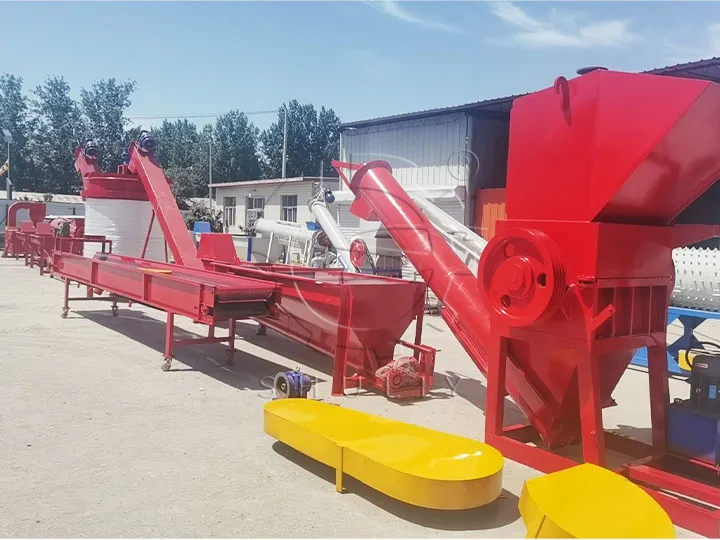مع تحول الاهتمام العالمي نحو التنمية المستدامة، أصبحت إعادة تدوير البلاستيك بعد الاستهلاك جزءًا حيويًا من صناعة البلاستيك. إن إعادة تدوير المواد البلاستيكية وإعادة استخدامها لا تقلل من الطلب على المواد الخام فحسب، بل تخفف أيضًا من التلوث البيئي بشكل فعال. تقدم هذه المقالة أربع مواد شائعة قابلة لإعادة التدوير بعد الاستهلاك - PP، وHDPE، وLDPE، وPET - وتستكشف خصائصها وقيمة إعادة التدوير.
أربعة أنواع من المواد القابلة لإعادة التدوير بعد الاستهلاك
PP (البولي بروبيلين)
يُعرف PP (البولي بروبيلين) بمتانته العالية وكثافته المنخفضة، مما يجعله قابلاً للتطبيق على نطاق واسع في مختلف الصناعات.
- المصادر: حاويات المواد الغذائية، وصناديق الوجبات الجاهزة، وأغطية الزجاجات، وقطع غيار السيارات، وما إلى ذلك.
- عملية إعادة التدوير: يتم فرز نفايات PP، تمزيقهوتنظيفها وتجفيفها ومعالجتها إلى كريات معاد تدويرها، والتي يمكن استخدامها لإنتاج الأنابيب أو أفلام التغليف أو المنتجات المنزلية.
- القيمة: بفضل خصائصه الفيزيائية الممتازة، يعد البولي بروبلين المعاد تدويره متعدد الاستخدامات للغاية في التصنيع، مما يقلل الاعتماد على المواد البلاستيكية الجديدة.



HDPE (البولي إيثيلين عالي الكثافة)
HDPE (البولي إيثيلين عالي الكثافة) هو بلاستيك مقاوم للمواد الكيميائية وسهل المعالجة، مثالي لمختلف المنتجات القوية.
- المصادر: زجاجات منظفات الغسيل، وأباريق الحليب، والأوعية الكيميائية، والأنابيب البلاستيكية، وغيرها.
- عملية إعادة التدوير: يتم تمزيق بلاستيك HDPE وتنظيفه وإخراجه مكعبات إلى مواد معاد تدويرها تُستخدم لإنتاج صناديق القمامة وبلاط الأرضيات ومواد البناء.
- القيمة: تسمح قابلية إعادة التدوير الاستثنائية لـ HDPE بدورات إعادة استخدام متعددة، والحفاظ على الموارد وتقليل الاعتماد على المواد البلاستيكية الخام.



LDPE (البولي إيثيلين منخفض الكثافة)
يستخدم البولي إيثيلين منخفض الكثافة (LDPE) بشكل أساسي في الأفلام البلاستيكية، ويلعب دورًا مهمًا في الحياة اليومية.
- المصادر: الأكياس البلاستيكية، والبلاستيك فيلم، والتغليف السريع، والأفلام الزراعية، الخ.
- عملية إعادة التدوير: يخضع بلاستيك LDPE للفرز والتقطيع والتنظيف والتجفيف والتكوير، ثم تتم معالجته في أكياس القمامة أو الأفلام البلاستيكية أو غيرها من المنتجات البلاستيكية المرنة.
- القيمة: على الرغم من صعوبة إعادة تدويره نسبيًا، فإن إعادة تدوير البولي إيثيلين المنخفض الكثافة (LDPE) أمر بالغ الأهمية لتقليل التلوث البلاستيكي، خاصة في إعادة استخدام الأفلام البلاستيكية ذات الاستخدام الواحد.



PET (البولي ايثيلين تيريفثاليت)
PET (البولي إيثيلين تيريفثاليت) هو المادة الرئيسية لزجاجات المشروبات، المعروفة بخفة الوزن والشفافية.
- المصادر: عبوات المياه المعبأة، وزجاجات الصودا، وجرار الطعام، وما إلى ذلك.
- عملية إعادة تدوير PET: تتم إزالة الزجاجات البلاستيكية من ملصقاتها، وسحقها، وغسلها، وتجفيفها لصنع رقائق زجاجات PET، والتي يمكن استخدامها في إنتاج الألياف المعاد تدويرها، وتغليف المواد الغذائية، والزجاجات الجديدة.
- القيمة: تتميز مادة PET بواحدة من أعلى معدلات إعادة التدوير بين المواد البلاستيكية، مما يجعل إعادة استخدامها مؤثرة بشكل كبير في الحد من التلوث البيئي.



تعد PP وHDPE وLDPE وPET أكثر المواد القابلة لإعادة التدوير بعد الاستهلاك شيوعًا في صناعة إعادة تدوير البلاستيك. ومن خلال الفرز وإعادة التدوير المناسبين، يمكن تحويل هذه النفايات البلاستيكية إلى موارد معاد تدويرها عالية القيمة، مما يؤدي إلى تطوير الاستخدام الدائري للبلاستيك.
الشركة المصنعة لآلة إعادة التدوير-مجموعة Shuliy
باعتبارنا مصنعًا محترفًا لآلات إعادة التدوير، فإننا ملتزمون بتوفير حلول إعادة تدوير فعالة ودائمة للعملاء في جميع أنحاء العالم. تغطي معداتنا عملية إعادة التدوير بأكملها، بدءًا من الغسيل ونزح المياه وحتى التكوير، ويمكن تخصيصها لتلبية احتياجات العملاء المحددة، مما يساعد على تحسين كفاءة إعادة التدوير وجودة المنتج.


إذا قمت بجمع كمية كبيرة من المواد القابلة لإعادة التدوير بعد الاستهلاك، فيمكنك ترك رسالة على موقعنا الإلكتروني وسنقدم لك الحل المناسب للمواد الخاصة بك.










